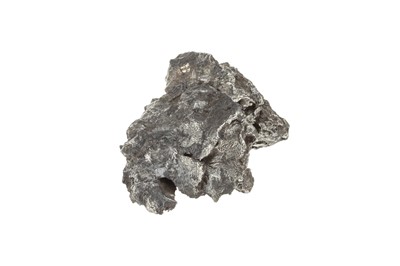12th May, 2022 12:00
Fine Scientific and Medical Instruments
A Rugged Sikhote-Alin Meteorite
this aesthetic meteorite example has a gunmetal patina with a rugged surface which is the result of the iron meteorite exploding high in the atmosphere and being ripped apart along its crystalline plane. It originates from the largest known meteorite shower to have occurred since the dawn of civilization.
Analysis – classified as an iron meteorite belonging to the meteorite group IIAB and with a coarse octahedrite structure Group, typically 93% Iron5.9% Nickel, 0.42% Copper, 0.46% Phosphorus
Location: Sikhote-Alin Mountains, Maritime Prov, Russia
Time of fall: 10:38 am 12/02/1947
Dimensions: 6.5cm x 4.8cm x 2.4cm, weight 0.208kg
Footnote: At around 10:30 on 12 February 1947, eyewitnesses in the Sikhote-Alin Mountains, Primorye, Soviet Union, observed a large light brighter than the sun that came out of the north and descended at an angle of about 41 degrees. The bright flash and the deafening sound of the fall were observed for 300 kilometres (190 mi) around the point of impact not far from Luchegorsk and approximately 440 km (270 mi) northeast of Vladivostok. A smoke trail, estimated at 32 km (20 mi) long, remained in the sky for several hours
Sold for £362
Result plus buyers premium
this aesthetic meteorite example has a gunmetal patina with a rugged surface which is the result of the iron meteorite exploding high in the atmosphere and being ripped apart along its crystalline plane. It originates from the largest known meteorite shower to have occurred since the dawn of civilization.
Analysis – classified as an iron meteorite belonging to the meteorite group IIAB and with a coarse octahedrite structure Group, typically 93% Iron5.9% Nickel, 0.42% Copper, 0.46% Phosphorus
Location: Sikhote-Alin Mountains, Maritime Prov, Russia
Time of fall: 10:38 am 12/02/1947
Dimensions: 6.5cm x 4.8cm x 2.4cm, weight 0.208kg
Footnote: At around 10:30 on 12 February 1947, eyewitnesses in the Sikhote-Alin Mountains, Primorye, Soviet Union, observed a large light brighter than the sun that came out of the north and descended at an angle of about 41 degrees. The bright flash and the deafening sound of the fall were observed for 300 kilometres (190 mi) around the point of impact not far from Luchegorsk and approximately 440 km (270 mi) northeast of Vladivostok. A smoke trail, estimated at 32 km (20 mi) long, remained in the sky for several hours
Auction: Fine Scientific and Medical Instruments, 12th May, 2022



